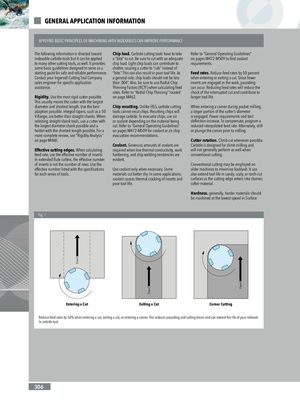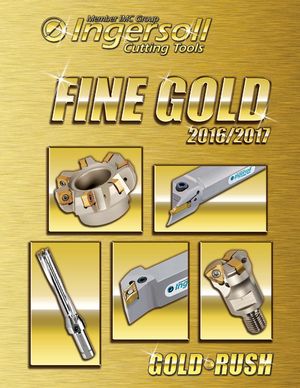Общий каталог Ingersoll 2011 - страница 304
Навигация
- 0003 Table of Contents
- 0006 End Mills
- 0064 Long Edge
- 0104 0Deg Face Mills
- 0160 Face Mills
- 0202 Slotters
- 0218 Form Mills
- 0236 Profile Mills
- 0302 Milling Tech
- 0384 Solid Carbide
- 0448 Solid Carbide Tech
- 0474 Holemaking & Thread Milling
- 0666 Holemaking & Thread Milling Tech
- 0720 Innofit Top On Toolholders
- 0738 HSK Toolholders
- 0774 CAT Toolholders
- 0796 BT Toolholders
- 0816 Adaptions Accessories
- 0872 Turning Inserts
- 1024 Turning Holders
- 1144 Turning Tech
- 1174 Threading Inserts
- 1242 Threading Holders
- 1256 Threading Tech
- 1268 T-Clamp
- 1344 T-Clamp Tech
- 1376 T-CAP
- 1388 T-CAP Tech
- 1394 Product_Index

GENERAL APPLICATION INFORMATION APPLYING BASIC PRINCIPLES OF MACHINING WITH INDEXABLES CAN IMPROVE PERFORMANCE The following information is directed toward Chip load. Carbide cutting tools have to take Refer to “General Operating Guidelines” indexable carbide tools but it can be applied a “bite” to cut. Be sure to cut with an adequate on pages M472-M509 to find coolant to many other cutting tools, as well. It provides chip load. Light chip loads can contribute to requirements. some basic guidelines designed to serve as a chatter, causing a cutter to “rub” instead of starting point for safe and reliable performance. “bite.” This can also result in poor tool life. As Feed rates. Reduce feed rates by 50 percent Contact your Ingersoll Cutting Tool Company a general rule, chip loads should not be less when entering or exiting a cut. Since fewer sales engineer for specific application than .004”. Also, be sure to use Radial Chip inserts are engaged in the work, pounding assistance. Thinning Factors (RCTF) when calculating feed can occur. Reducing feed rates will reduce the rates. Refer to “Radial Chip Thinning” located shock of the interrupted cut and contribute to Rigidity. Use the most rigid cutter possible. on page M462. longer tool life. This usually means the cutter with the largest diameter and shortest length. Use the best Chip recutting. Unlike HSS, carbide cutting When entering a corner during pocket milling, adaption possible. Integral tapers, such as a 50 tools cannot recut chips. Recutting chips will a larger portion of the cutter’s diameter V-flange, are better than straight shanks. When damage carbide. To evacuate chips, use air is engaged. Power requirements and tool selecting straight shank tools, use a cutter with or coolant depending on the material being deflection increase. To compensate, program a the largest diameter shank possible and a cut. Refer to “General Operating Guidelines” reduced interpolated feed rate. Alternately, drill holder with the shortest length possible. For a on pages M472-M509 for coolant or air chip or plunge the corner prior to milling. more complete review, see “Rigidity Analysis” evacuation recommendations. on page M460. Cutter rotation. Climb cut whenever possible. Coolant. Generous amounts of coolant are Carbide is designed for climb milling and Effective cutting edges. When calculating required when low thermal conductivity, work will not generally perform as well when feed rate, use the effective number of inserts. hardening, and chip welding tendencies are conventional cutting. In extended flute cutters, the effective number evident. of inserts is not the number of rows. Use the Conventional cutting may be employed on effective number listed with the specifications Use coolant only when necessary. Some older machines to minimize backlash. It can for each series of tools. materials cut better dry. In some applications, also extend tool life in sandy, scaly, or torch-cut coolant causes thermal cracking of inserts and surfaces as the cutting edge enters into cleaner, poor tool life. softer material. Hardness. generally, harder materials should be machined at the lowest speed in Surface Fig. 1 Entering a Cut Exiting a Cut Corner Cutting Reduce feed rates by 50% when entering a cut, exiting a cut, or entering a corner. This reduces pounding and cutting forces and can extend the life of your indexab- le carbide tool. 306 Feed Feed Feed
 Общий каталог Ingersoll 2016 - 2017
Общий каталог Ingersoll 2016 - 2017 Общий каталог Ingersoll 2014
Общий каталог Ingersoll 2014 Каталог Ingersoll инструмент для нарезания резьбы
Каталог Ingersoll инструмент для нарезания резьбы Общий каталог Ingersoll 2013 - 2014
Общий каталог Ingersoll 2013 - 2014 Каталог Ingersoll новинки 2021
Каталог Ingersoll новинки 2021